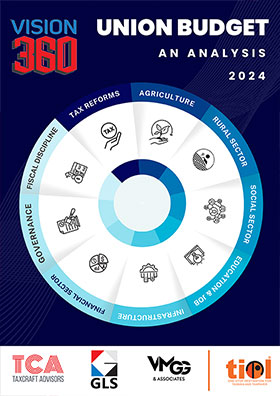By TIOL News Service NEW DELHI, FEB 11, 2012: THE levy of service tax on construction services has constantly been generating litigation for virtually all central excise zones in India. Every Commissionerate has been sending DO letters to the Board, seeking clarifications in the light of various business models being followed by the taxpayers. Across the country, divergent business models and practices are being followed in the construction sector. Some of these business models and practices could be region specific. Choosing important issues from the basket of references, the TRU has finally come out with a detailed clarification which may bring relief to some but may also give rise to litigation. Highlights of the clarifications are as follows: ++ Tripartite Business Model (Parties in the model: (i) landowner; (ii) builder or developer; and (iii) contractor who undertakes construction): Issue involved is regarding the liability to pay service tax on flats/houses agreed to be given by builder/developer to the land owner towards the land /development rights and to other buyers. Clarification: Here two important transactions are identifiable: (a) sale of land by the landowner which is not a taxable service; and (b) construction service provided by the builder/developer. The builder/developer receives consideration for the construction service provided by him, from two categories of service receivers: (a) from landowner: in the form of land/development rights; and (b) from other buyers: normally in cash. (A) Taxability of the construction service: (i) For the period prior to 01/07/2010: construction service provided by the builder/developer will not be taxable, in terms of Board’s Circular No.108/02/2009-ST dated 29.01.2009. (ii) For the period after 01/07/2010, construction service provided by the builder/developer is taxable in case any part of the payment/development rights of the land was received by the builder/ developer before the issuance of completion certificate and the service tax would be required to be paid by builder/developers even for the flats given to the land owner.
(B) Valuation: (i )Value, in the case of flats given to first category of service receiver, is determinable in terms of section 67(1)(iii) read with rule 3(a) of Service Tax (Determination of Value) Rules, 2006, as the consideration for these flats i.e., value of land / development rights in the land may not be ascertainable ordinarily. Accordingly, the value of these flats would be equal to the value of similar flats charged by the builder/developer from the second category of service receivers. In case the prices of flats/houses undergo a change over the period of sale (from the first sale of flat/house in the residential complex to the last sale of the flat/house), the value of similar flats as are sold nearer to the date on which land is being made available for construction should be used for arriving at the value for the purpose of tax. Service tax is liable to be paid by the builder/developer on the ‘construction service’ involved in the flats to be given to the land owner, at the time when the possession or right in the property of the said flats are transferred to the land owner by entering into a conveyance deed or similar instrument(eg. allotment letter). (ii) Value, in the case of flats given to the second category of service receivers, shall be determined in terms of section 67 of the Finance Act, 1994.
++ Investment model: In this model, before the commencement of the project, the same is on offer to investors. Either a specified area of construction is earmarked or a flat of a specified area is allotted to the investors and as it happens in some places, additionally the investor may also be promised a fixed rate of interest. After a certain specified period an investor has the option either to exit from the project on receipt of the amount invested alongwith interest or he can re-sell the said allotment to another buyer or retain the flat for his own use. Clarification: In this model, after 01/07/2010, investment amount shall be treated as consideration paid in advance for the construction service to be provided by the builder/developer to the investor and the said amount would be subject to service tax. If the investor decides to exit from the project at a later date, either before or after the issuance of completion certificate, the builder/developer would be entitled to take credit under rule 6(3) of the Service Tax Rules, 1994( to the extent he has refunded the original amount). If the builder/developer resells the flat before the issuance of completion certificate, again tax liability would arise. ++ Build- Operate - Transfer (BOT) Projects: Many variants of this model are being followed in different regions of the country, depending on the nature of the project. Build-Own-Operate-Transfer (BOOT) is a popular variant. Generally under BOT model, Government or its agency, concessionaire (who may be a developer/builder himself or may be independent) and the users are the parties. Risk taking and sharing ability of the parties concerned is the essence of a BOT project. Government or its agency by an agreement transfers the ‘right to use’ and/or ‘right to develop’ for a period specified, usually thirty years or near about, to the concessionaire. Clarification: Transactions involving taxable service take place usually at three different levels: firstly, between Government or its agency and the concessionaire; secondly, between concessionaire and the contractor and thirdly, between concessionaire and users, all in terms of specific agreements. At the first level, Government or its agency transfers the right to use and/or develop the land, to the concessionaire, for a specific period, for construction of a building for furtherance of business or commerce (partly or wholly). Consideration for this taxable service may be in the nature of upfront lease amount or annual charges paid by the concessionaire to the Government or its agency. Here the Government or its agency is providing ‘renting of immovable property service’ (renting of vacant land to be used for furtherance of business or commerce) and in such cases the concessionaire becomes the service receiver. In this model, though the concessionaire is undertaking construction of a building to be used wholly or partly for furtherance of business or commerce, on the land provided by the government or its agency for temporary use, he will not be treated as a service provider since such construction has been undertaken by him on his own account and he remains the owner of the building during the concession period. At the second level, transaction can take place between a concessionaire and the contractor. Where the concessionaire himself does not have exposure to construction sector, he may engage a contractor for undertaking construction of a building on the land, in respect of which right to use has been obtained in his favour, from the Government or its agency. If the concessionaire is himself a builder/developer, this level of transaction may not arise. Where an independent contractor is engaged by a concessionaire for undertaking construction for him, then service tax is payable on the construction service provided by the contractor to the concessionaire. At the third level, the concessionaire enters into agreement with several users for commercially exploiting the building developed/constructed by him, during the lease period. For example, the user may be paying a rent or premium on the sub-lease for temporary use of immovable property or part thereof, to the concessionaire. At this third level, concessionaire is the service provider and user of the building is the service receiver. The concessionaire may provide to the users, taxable services such as ‘renting of immovable property service’, ‘business support service’, ‘management, maintenance or repair service’, ‘sale of space for advertisement’, etc. Service tax is leviable on the taxable services provided by the concessionaire to the users. There could be many variants of the BOT model explained above and implications of tax may differ. For example, at times it is possible that the concessionaire may outsource the management or commercial exploitation of the building developed/constructed by him, to another person and may receive a pre-determined amount as commission. Taxable service here will be business auxiliary service and service tax is leviable on the commission. (A) Taxability: (i) the service provided by the Government or its agency to the concessionaire is liable to service tax; (ii) the construction services provided by the contractor to the concessionaire would be examined from the point of taxability as to whether the activity is not otherwise excluded; (iii) the services provided by the concessionaire to the user of the facility are liable to service tax;
(B) Persons liable to pay tax: Government or its agency and concessionaire are liable to pay tax on the services being provided by them. There could be several other persons liable to pay service tax, depending on the variant of the BOT model followed. 2.7 Joint Development Agreement Model: Under this model, land owner and builder/developer join hands and may either create a new entity or otherwise operate as an unincorporated association, on partnership /joint / collaboration basis, with mutuality of interest and to share common risk/profit together. The new entity undertakes construction on behalf of landowner and builder/developer. Clarification: Circular 148/17/2011-ST dated 13/12/2011, particularly paragraphs 7, 8, 9 apply mutandis mutandis in this regard. |









 Download PDF
Download PDF




